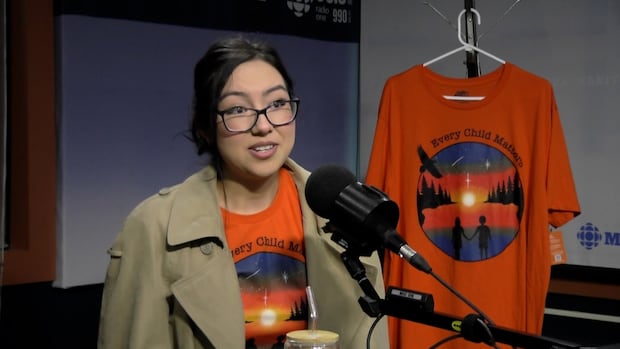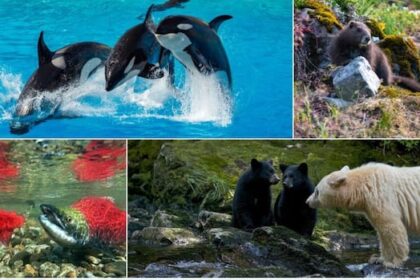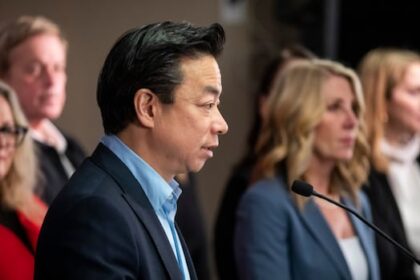IndigenousA design contest winner, a director of a charity for residential school survivors and their families, and the originator of the orange shirt movement talk about its meaning.Orange Shirt Day, or the National Day for Truth and Reconciliation, is Sept. 30Miki Wolf · CBC News · Posted: Sep 12, 2025 1:36 PM EDT | Last Updated: 2 hours agoBrooklyn Rudolph-Nicholas from the Pimicikamak Cree Nation in Manitoba designed an orange T-shirt for Walmart Canada. (CBC)Honouring loved ones who have passed. Supporting workshops and crisis resources for communities in need. A guiding symbol for the journey of reconciliation across Canada. These are just some of the reasons three first First Nations women say that orange shirts matter.Brooklyn Rudolph-Nicholas, an artist from Pimicikamak Cree Nation in Manitoba, won the 2025 National Day for Truth and Reconciliation T-shirt design contest, a partnership between Walmart Canada and Indigenous Proud, an organization that supports Indigenous artistic opportunities across arts, language, and cultural sectors. Her late grandparents were both residential school survivors.”I wanted to showcase and honour them, as well as all the children that attended these schools,” Rudolph-Nicholas told CBC Manitoba’s Information Radio host Marcy Markusa.”The eagle flying above represents love, one of the seven sacred teachings, and the star in the middle there represents keewatin. In Cree, that means the ‘going home star,’ guiding the children home,” she said.Orange T-shirts with Brooklyn Rudolph-Nicholas’s design are being sold by Walmart this fall. (Brooklyn Rudolph Art/Facebook)Rudolph-Nicholas said she appreciates the support she’s been receiving for the design.”I’m very happy because I’ve gotten so much love so far from all over coast to coast,” she said.”It feels surreal and I know that I’m making them proud.” Why orange shirts?The shirts are worn on Sept. 30 to raise awareness about the legacy of residential schools and their impact on Indigenous children and their families across Canada. The movement was started by Phyllis Webstad, a residential school survivor who was forced to attend St. Joseph’s Mission, an institution near Williams Lake, B.C., at age six. Her orange shirt, given to her by her grandmother for the first day of school, was taken away from her, along with the rest of her clothing, upon her arrival at the school.As more people began wearing orange shirts on Sept. 30, now the National Day for Truth and Reconciliation, large retailers have started to offer orange shirt merchandise.Angela White, executive director of the Indian Residential Schools Survivor Society (IRSSS), a B.C. charity with offices across the province, said the money her organization receives from orange shirt campaigns are used for everything from workshops to a national crisis hotline.Angela White, of the Snuneymuxw First Nation, is the executive director of the Indian Residential School Survivors’ Society, based out of British Columbia. (Indian Residential School Survivors’ Society )”We’re always at risk of losing really important dollars that our communities rely on for mental health and safety and healing and so through these connections that we are partnering up with, it allows us to put funding towards the lost funding that we’re always constantly dealing with,” White said.”I call us the little organization that could because I always said we were always working on a bologna budget, but wishing for steak and lobster dinner.”The profits from Rudolph-Nicholas’s T-shirts will be split between the IRSSS and the Orange Shirt Society founded by Webstad.New bookWebstad, who is from Stswecem’c Xgat’tem First Nation in the central interior of B.C., has a new book Decolonization and Me in which she reflects on residential schools and her own healing journey.In an interview with CBC Radio’s Up to Speed, Webstad said “the whole orange shirt movement has been divinely guided and I believe the ancestors and the children, they’re behind everything that’s happening.”Phyllis Webstad visits the Kehkimin Wolastoqey language immersion school in New Brunswick in May 2023. (Ann Paul/CBC)”I’ve done my best to show up and do what I need to do to keep the conversation going.”She hopes the book will shed light on the work that still needs to be done on the path to truth and reconciliation, and that it attempts to “fill in the gaps of understanding” for those who may hold denialist views.”There’s a lot of work to do. So just instead of denying, come and help us. We need help,” she said.ABOUT THE AUTHORMiki Wolf is a journalist with CBC Indigenous, specializing in video storytelling. Miki is Agunda (Wolf) clan from the Champagne and Aishihik First Nation in the Yukon, and holds a master’s degree from Liverpool John Moores University. With files from CBC Manitoba’s Information Radio and Up to Speed
Sunday, 21 Dec 2025
Canada – The Illusion
Search
Have an existing account?
Sign In
© 2022 Foxiz News Network. Ruby Design Company. All Rights Reserved.
You May also Like
- More News:
- history
- Standing Bear Network
- John Gonzalez
- ᐊᔭᐦᑊ ayahp — It happened
- Creation
- Beneath the Water
- Olympic gold medal
- Jim Thorpe
- type O blood
- the bringer of life
- Raven
- Wás’agi
- NoiseCat
- 'Sugarcane'
- The rivers still sing
- ᑲᓂᐸᐏᐟ ᒪᐢᑿ
- ᐅᑳᐤ okâw — We remember
- ᐊᓂᓈᐯᐃᐧᐣ aninâpêwin — Truth
- This is what it means to be human.
- Nokoma











